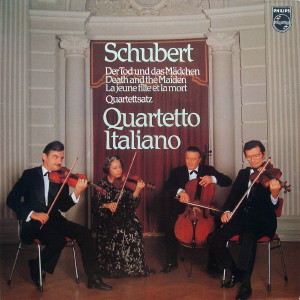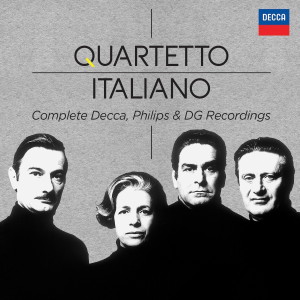 |
|
Philips
- 1 LP - 9500 751 - (p) 1980
|
 |
| Decca -
37 CDs - 478 8824 - (c) 2015 |
|
| Franz Schubert
(1797-1828) |
|
|
|
|
|
|
|
| String
Quartet No. 14 in D minor, D 810
"Death and the Maiden" |
|
39' 38" |
|
| -
Allegro |
12' 39" |
|
|
-
Andante con moto
|
13' 45" |
|
|
| -
Scherzo. Allegro molto |
4' 05" |
|
|
| -
Presto |
9' 09" |
|
|
|
|
|
|
| String
Quartet No. 12 in C minor, D 703
"Quartettsatz" |
|
11' 21" |
|
-
Allegro assai
|
10' 21" |
|
|
|
|
|
|
QUARTETTO ITALIANO
- Paolo Borciani, Elisa Pegreffi, violino
- Dino Asciolla, viola
- Franco Rossi, violoncello
|
|
|
|
|
|
Luogo e data
di registrazione |
|
Musica-Théâtre,
Salle de Musique, La
Chaux-de-Fonds (Svizzera)
- 21-24
ottobre 1979 |
|
|
Registrazione: live
/ studio |
|
studio |
|
|
Producer / Engineer |
|
Wilhelm
Hellweg
| Willem
van Leewen |
|
|
Prima Edizione LP |
|
Philips
| 9500
751 | 1
LP | (p) 1980
|
|
|
Prima Edizione CD |
|
Decca | 478
8824 | 37
CDs - (30°, 5-8, 9) | (c) 2015 | ADD |
|
|
Note |
|
-
|
|
|
|
|
Schubert's
quartets date from between
1812 and 1826 and hence
were contemporary with the
quartets of Beethoven's
middle and late periods;
as both composers were
living in Vienna, this
proximity of time and
place for a long time led
to Schubert's works being
compared with those of
Beethoven, the latter
being seen as a model
against which other
developments and
deviations were to be
judged and often censured.
There can be no doubt that
Beethoven's music was of
great importance to the
younger composer, yet
there is equally no dout
that his influence has
been overstomated for in
Schubert's early works it
is rather Haydn who is the
major model while in his
mature works from 1820
onwards Schubert's is so
very much an independent
composer that such models
are no longer relevant.
The
quartet movement in C
minor, D. 703, which was
all that was completed
of a planned quartet
begun in the winter of
1820, ist the first to
show a new fevel of
compositional thought
after numerous derivate
quartets of his younger
days. Einstein wrote
that "there is no bridge
leading to it from
earlier quartets," and
the only pointers to
Schubert's immediately
preceding development
are to be found in the
similarly unfinished
sonata fragments for
piano of 1817-19. In the
"Quartettsatz" there is
a strikingly imaginative
free handling of sonata
form, which had hitherto
served as a formal
scheme of unquestioned
rigidity; now, however,
Classical principles of
construction appear to
have only a limited
relevance since Schubert
is no longer proceeding
from differentiated
types of theme but from
contrasting gestures;
thus the dynamic
and dramatic opening
takes the place of the
first-subject group,
even though it many not
settle into a
fixed melodic shape.
The prevailing
features here are
sheer sonority,
dynamism, movement,
and rhythmic
ostinatos; by contrast
the tuneful lyrical
section representing
the second subject is
so solidly constructed
as a self-contained
song-like melody
sealed off from the
rest that in the
context of the whole
movement its effect is
somewhat static and
episode-like; it
provides the
characteristic sound
and structure of a
slow movement, and
this may have induced
Schubert to break off
work on the second
movement - of which a
fragment in A flat 41
bars long has survived
- as being
tautologous.
Tunefulness
is also a key word
in describing the D
minor Quartet D.
810, which was begun
in 1824 but not
completed until 1826
and first performed at a
domestic concert
in the home at the
court singer Josef
Barth. As in his
previous A major
Piano Quintet D.
667 here again
Schubert quotes
from himself, he
based the slow
movement on his
setting of
Matthias
Claudius's poem
"Death and the
Maiden" (D. 531)
from 1817. With
its pervasive
minor mode
appearing in all
four movements and
alleviated only at
the close of the
slow movement and
in the trio of the
dance movement
this is the most
melancholy and at
the same teme, the
most dramatic of
Schubert's
quartets. The
thematically open
and rhythmically
active
introduction to
the first movement
shows some kinship
with the C minor
"Quartettsatz,"
the difference
being that here
the distinctive
rhythmic figure
permeates the
entire work and
binds it into a cyclical
unity. Once
again we find a
trasnsformation
of the usual
functions within
sonata form
motivic working
yelds in
importance to
the play of
harmonic
colours,
oflayered
rhythms and the
structurally
vital contrast
between triplets
and dotted
rhythms. By
contrast the
construction of
the variation
movement is
almost
suspiciously
simple a theme
composing 24
bars, five
variations which
leeve its
harmonic
articulation and
format
construction
intact, and a
coda which leads
back to the
theme. after
this point of
repose, the
dance movement,
with its tension
between the
syncopated
scherzo and the
calm. Ländler-like,
even almost
sweet D major
trio, sparks off
a fresh
contrast which
flares up in the
finale a raging
broadly laid-out
Presto
encompassing
well over 700
bars. Its
articulation and
sonority appear
to have been
conceived in
almost
orchestral terms
broad unisons
involving all
the instruments,
expansive washes
of sound with
varying rhythmic
structures applied to
them. Here we may find
a manner of writing
which has very little
to do with the
analyctical principles
of Beethoven's technique
but eather looks
forward to the work of
such composers as
Bruckner, Hugo Wolf
and Gustav Mahler.
Wulf
Konold
|
|
|